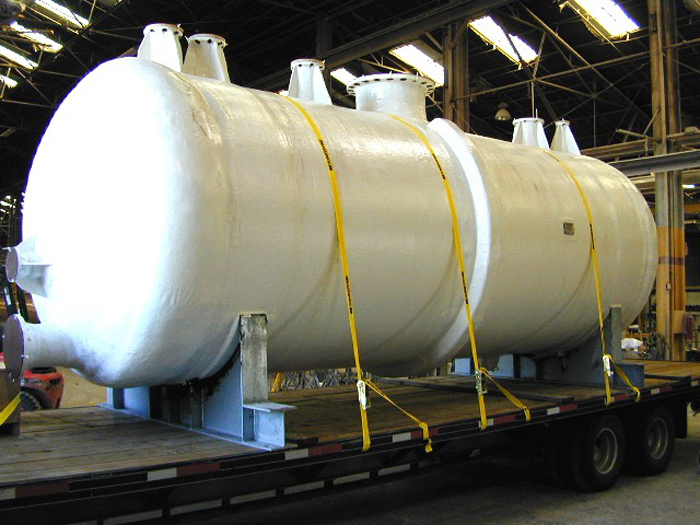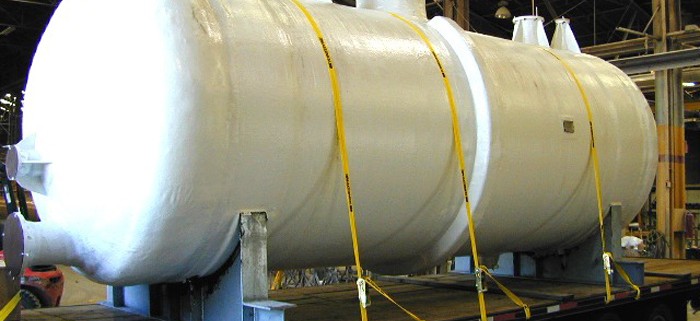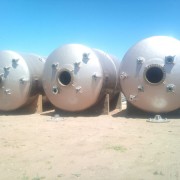Storing Sulfuric Acid Using Fiberglass as a Material of Construction
 Choosing the proper material of construction for acid storage is critical to the success of your project and will depend on a number of factors, such as, storage temperature, concentration or purity, tank size, and costs. By many accounts carbon steel is the most common material of construction for this application. However, there are other options, for example, fiberglass, which has been employed in some of the most chemically aggressive and corrosive environments in a multitude of industries including chemical processing and storage. With respect to alloys, as materials of construction, stainless steel, anode protection, and or phenolic or glass linings are sometimes utilized, perhaps less frequently, and their use often contingent upon design specifications.
Choosing the proper material of construction for acid storage is critical to the success of your project and will depend on a number of factors, such as, storage temperature, concentration or purity, tank size, and costs. By many accounts carbon steel is the most common material of construction for this application. However, there are other options, for example, fiberglass, which has been employed in some of the most chemically aggressive and corrosive environments in a multitude of industries including chemical processing and storage. With respect to alloys, as materials of construction, stainless steel, anode protection, and or phenolic or glass linings are sometimes utilized, perhaps less frequently, and their use often contingent upon design specifications.
Fiberglass is a unique material that can be utilized effectively for corrosive storage, including sulfuric acid. When considering the entire portfolio of benefits an end-user may leverage or enjoy when employing fiberglass it becomes clear that there are multi-functional attributes of fiberglass that may increase its cost-effectiveness. Further, the constructability of custom fiberglass materials imparts multi-functional qualities that are desirable, such as, ease of installation and design synchronization; fiberglass designed to your specifications will interface with existing infrastructure or plant layout. You’ll want to refer to a resin manufacture guide and or speak with our team of engineers to discuss specifications and design considerations
Perhaps often overlooked in these types of articles is the interdependence between complex operating systems and their functional components or elements of design (tanks, pipe, etc.). Moreover, fiberglass boasts long-life cycles in extremely corrosive environments and it should be considered that there may exist a significant connection between fiberglass and resiliency of the plant or and or operation, and or sustainability of function regarding plant operations. How does a plant or complex system deal with change or a disturbance in flow of day-to-day operations? Fiberglass may provide some answers to this question by providing a diverse range of positive attributes. Which is to say, there is something worth exploring or potentially redeeming about the notion of adaptability in the context of the materials used, flexibility of the plant, relationships or connections that exist between life-cycles, cost-effectiveness, service life, ease of repair, and importantly—reduced plant down time.
Corrosion resistance is chief among concerns for any firm handling acids or other corrosives such as sulfuric acid. Corrosion resistance of fiberglass is a function both of resin content and the specific resin used in the laminate. Generally speaking, the higher the resin content, the more corrosion resistant the laminate. The inherent corrosion resistant characteristic of our fiberglass materials makes it a cost-effective, strong, lightweight solution for corrosion resistant equipment applications in the chemical process industries. The selection of the proper type and thickness of the corrosion barrier/liner can more than double the service life of the material. When storing or handling sulfuric acid, the addition of a corrosion barrier/liner is essential and can become an important cost savings to the end- user, providing the lowest cost per year of service life.
There are few good options for storing sulfuric acid. Fiberglass is an exceptional material of construction when considering the entire portfolio of benefits is imparts to the end-user, and a highly effective option for the storage of sulfuric acid. Fiberglass benefits include: high strength-to-weight ratio, can be customized/formulated for corrosion resistance, abrasion resistance, smoke retardance, posses long life-cycles when compared to other materials, ease of repair, and overall durability.














